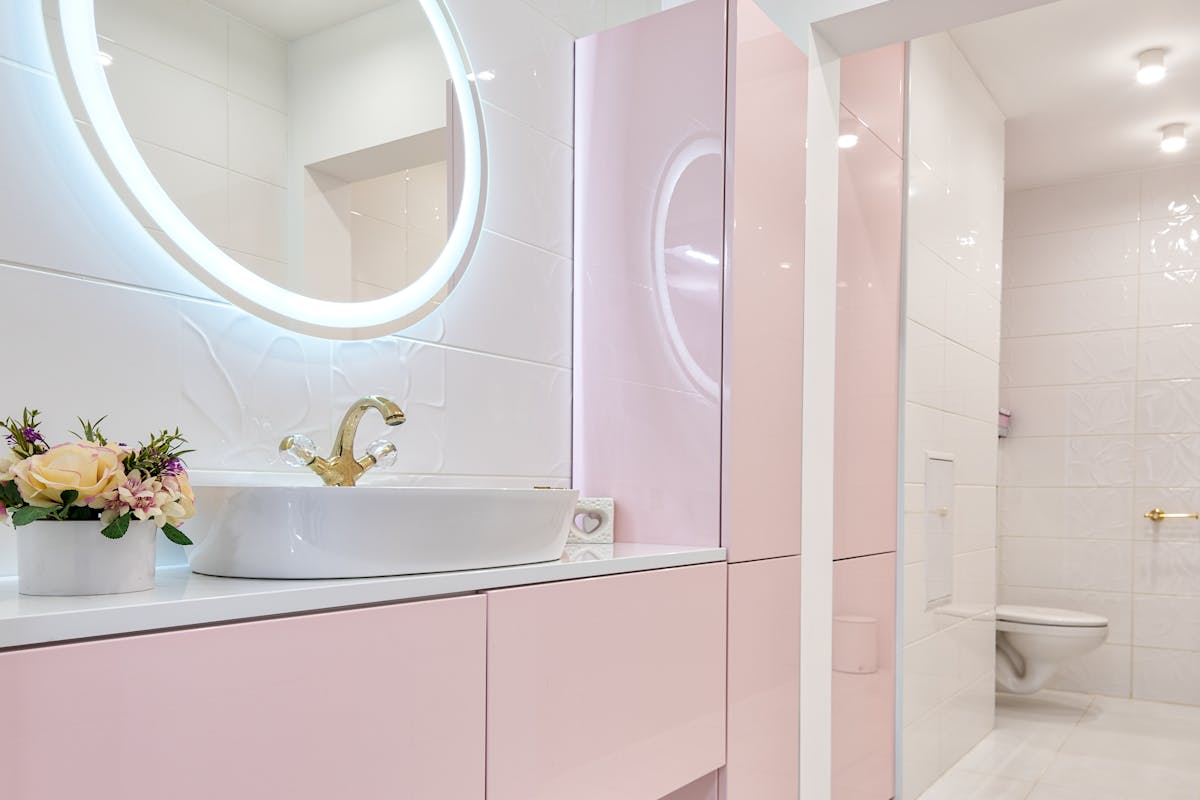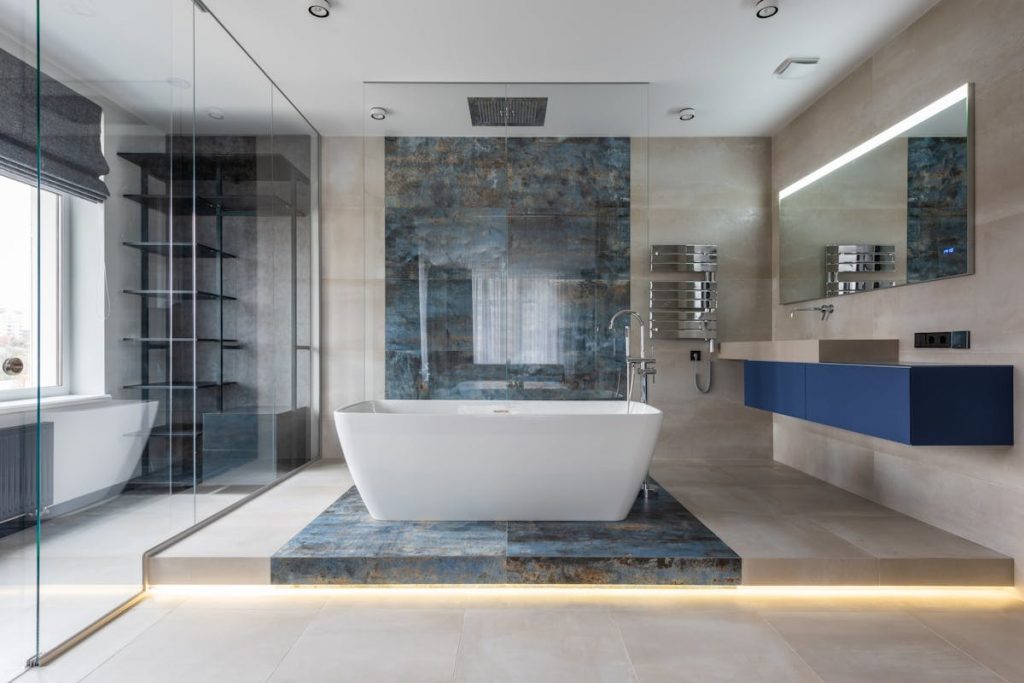- Upgrade to energy-efficient lighting and smart thermostats to reduce energy consumption and enhance bathroom functionality.
- Install temperature-controlled shower systems and low-flow plumbing to save water and ensure consistent, comfortable temperatures.
- Opt for sustainable materials like bamboo or recycled products for environmentally friendly bathroom renovations.
- Incorporate smart home technology for improved energy efficiency and convenience in bathroom design.
- Eco-friendly bathroom upgrades contribute to both the beauty of home spaces and the health of our planet.
In an era where sustainability is paramount, your bathroom, one of the most personal spaces in your home, warrants particular consideration during renovations. Eco-friendly bathroom updates reduce your environmental footprint and bring significant savings in water and energy bills. For the environmentally mindful homeowner, this post outlines innovative yet practical ways to reimagine your bathroom with the planet in mind. We’ll discuss materials that will transform your fixtures and surfaces, examine how clever design influences sustainability, and even touch on functionalities that appeal to franchise-conscious and planet-protectors.
Innovative Materials and Designs
Bathroom renovations represent a prime opportunity to both update your space’s aesthetics and incorporate eco-friendliness. By exploring new materials and fresh design approaches, you can ensure that luxurious and green are not mutually exclusive.
Recycled Materials
Innovative bathroom renovations often start with the materials, and recycled resources are a treasure trove of sustainable design choices. From stunning countertops made of glass from old windows to chic tiles crafted from recovered porcelain, the range of available recycled materials is astonishing. These options save waste from landfills and provide a distinctive look that no mass-produced ceramic can achieve.
Sustainable Wood Options
Choosing the right wood is crucial for an eco-conscious bathroom. Species like bamboo grow rapidly, meaning they are more sustainable than slow-growing alternatives. Reclaimed wood offers a unique story and appearance, having already served a function in another setting. These woods can be used for vanities, shelving, and even flooring, responsibly bringing nature into your space.
Low-Flow Fixtures
Water conservation is at the heart of any eco-friendly bathroom. Low-flow toilets, showerheads, and faucets can significantly reduce water usage without sacrificing comfort. In a typical home, bathrooms are responsible for almost 27% of indoor water use, so making strategic updates here can have a profound collective impact. For example, a family of four can save over 20,000 gallons of water annually by upgrading to low-flow fixtures.
Smart Lighting Solutions
Lighting plays a dual role in an eco-friendly bathroom. On one hand, energy-efficient LED bulbs can drastically reduce electricity usage, especially if you opt for fixtures with sensors that turn off when the room is vacant. On the other hand, maximizing natural light through skylights and larger windows minimizes the need for electric lighting. It can also contribute to the well-being of the bathroom’s occupants by providing a connection to the outdoors.

Efficient Use of Water and Energy
Optimizing your bathroom for efficiency goes beyond fixtures and finishes. It’s about creating a space where less is used more wisely.
Optimizing Water Use
Water scarcity is a growing concern, so optimizing bathroom water use is important. Consider aerated faucets and showerheads, which add air to the water flow to maintain pressure while using less water. Dual-flush toilets offer two flushing options: less water for liquid waste and a full flush for solid waste. These simple changes create a luxurious, functional, and eco-friendly bathroom.
Water Heater Efficiency
Selecting the right water heater is crucial in making your bathroom more eco-friendly and cost-efficient. Traditional water heaters always keep a large volume of water hot, which can be wasteful in terms of both water and energy. On the other hand, tankless water heaters heat water on demand, ensuring you only use energy when you need hot water. This can lead to significant savings on your utility bills. Additionally, consider solar water heaters that use renewable energy to heat your water, reducing your environmental footprint. Both choices are excellent steps towards a more sustainable and efficient bathroom.
Professional water heater repair is also crucial to ensure your water heater is functioning at its highest efficiency. This can include regular maintenance, such as flushing out sediment buildup to improve efficiency or repairing any leaks causing energy and water waste.
Energy-Efficient Ventilation
Proper ventilation is essential for maintaining air quality and preventing mold, but it can also be a significant source of energy use. Selecting an energy-efficient fan can cut these costs, and models with humidity sensors provide an on-demand function that won’t draw power unnecessarily. Natural ventilation is also worth exploring. Strategic window placement and vent designs can effectively circulate air without electricity, saving energy and creating a healthier, more comfortable bathroom environment.
Smart Technology Integration
Incorporating smart technology in your bathroom can significantly improve its efficiency and convenience. Motion sensor lighting ensures that lights are never left on when the room is unoccupied, while temperature-controlled shower systems save water and energy by maintaining consistent temperatures. Smart thermostats can also be integrated into your bathroom, allowing you to control the temperature and maximize energy efficiency. With the rise of smart home technology, the possibilities for creating an efficient and functional bathroom are endless.
Sustainable Materials
Choosing sustainable materials for your bathroom helps reduce waste and supports environmentally friendly practices. Look for recycled products or natural materials like bamboo, which has a much lower environmental impact than traditional hardwoods. Additionally, selecting low-flow plumbing fixtures can significantly reduce water consumption and save money on your utility bills.
Conclusion
Eco-friendly bathroom renovations present exciting opportunities for homeowners to merge technological advances with a renewed commitment to environmental stewardship. By replacing old, inefficient systems with new, sustainable options, we not only enhance the aesthetic appeal and functionality of our bathrooms but also make a meaningful contribution to the well-being of our planet. I encourage you to explore these ideas and leap into a greener, cleaner bathroom space. Each small step towards eco-friendly living in our homes brings us closer to a more sustainable future.

